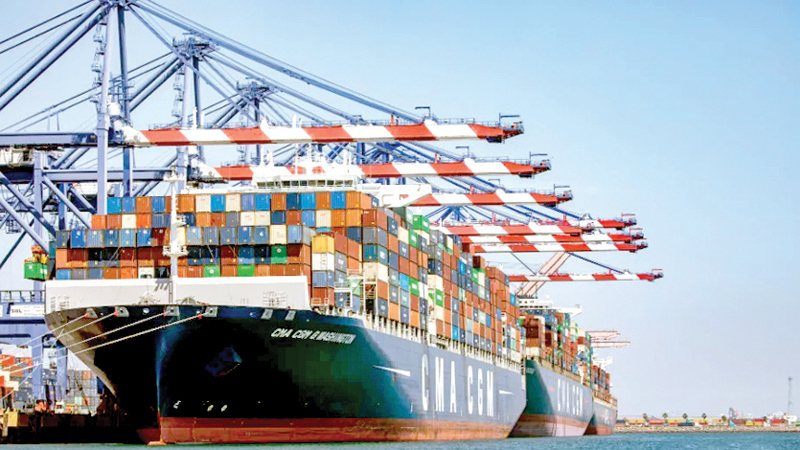 The Government, under its People’s Power Policy Framework, is pushing to establish an information technology economy valued at $5 billion by 2030, with the goal of creating 3,000 jobs in sectors such as Inland Revenue, the Customs, the Foreign Service and tourism. As part of this initiative, the authorities are tackling cargo congestion at Ports, particularly the Port of Colombo.
The Government, under its People’s Power Policy Framework, is pushing to establish an information technology economy valued at $5 billion by 2030, with the goal of creating 3,000 jobs in sectors such as Inland Revenue, the Customs, the Foreign Service and tourism. As part of this initiative, the authorities are tackling cargo congestion at Ports, particularly the Port of Colombo.
Efforts to digitalise cargo clearance include the automating processes such as document handling and verification which rely heavily on manual intervention. These inefficiencies often lead to delays, with even low-risk goods flagged for physical inspection. Such issues, combined with slow unloading, inspection and clearance procedures, have long contributed to bottlenecks in the cargo clearance process, according to a Customs officials.
Logistical bottlenecks
Delays in cargo clearance arise from various factors, including manual checks, interagency coordination issues, and inconsistent application of procedures. Logistical bottlenecks, random inspection and occasional regulatory inefficiencies further exacerbate the problem. Inefficiencies at Container Freight Stations (CFS) and warehouses—caused by space shortage or a lack of resources to handle high volumes—prolong shipment clearance.
Discrepancies in duty payment, tariff classification or valuations often require importers to provide additional documentation, further slowing the process. While not widespread, corruption and the expectation of unofficial payments can also create delays, with some Customs officers allegedly requesting bribes to expedite clearance.
The Automated System for Customs Data (ASYCUDA), an electronic platform for processing customs declarations, has helped streamline cargo clearance and reduce delays. However, its effectiveness is hindered by limited collaboration with other regulatory agencies. Authorities stress the need for seamless coordination to ensure compliance with national laws and safety standards.
Despite ASYCUDA’s contributions, congestion at the Port of Colombo remains a significant issue due to the high volume of imports and exports. Backlogs of containers awaiting inspection or clearance worsen during peak seasons, holidays, or sudden surges in cargo volume. According to Ports Minister Bimal Rathnayake, 30 ships bypassed the Colombo Port recently due to customs delays and truck congestion, a move shipping companies and importers say negatively impacts the country’s economy.
Container congestion
Amila Sanjeewa, President of the Customs Trade Union Alliance, attributes some ship diversions to logistical issues rather than container congestion alone. He accused certain business groups of spreading misinformation to discredit Sri Lanka Customs and mislead the President and Ports Minister. “We have observed parties with vested interests attempting to portray a bleak picture of the situation,” Sanjeewa said.
He said that container congestion has been a recurring issue at Colombo Port since 2012, particularly in the evenings and late at night. During the pandemic years (2020–2023), congestion eased due to reduced imports, a result of strict import restrictions and economic contraction. However, with the economy stabilising and trade activity increasing, congestion has returned to pre-pandemic levels.
Three container yards currently operate in the Colombo area: Grayline I (75-container capacity), Grayline II (100-container capacity), and the Rank Container Terminal (RCT), which handles 450–500 containers daily. About 80 percent of these containers are 40-feet long, requiring substantial unloading time. The lack of sufficient bays for unloading these larger containers causes significant delays, with some taking up to three days to unload.
Even with the construction of new yards, Sanjeewa said that without adequate facilities for 40-foot containers, congestion issues will persist. In 2024, import container volumes surged to 540,000 from 450,000 the previous year.
Government steps in
President Anura Kumara Dissanayake recently met stakeholders from across the logistics chain, including freight forwarders, transporters, shipping agents, and regulatory authorities, to address the delays. The President directed Sri Lanka Customs and the Ports Ministry to implement round-the-clock Customs operations allocate additional land for container storage and address staffing shortages in regulatory agencies.
One key initiative is the long-delayed construction of a common container yard in Kerawalapitiya, funded by the Asian Development Bank (ADB). First recommended in a 2020 ADB study, the facility will handle up to 3,000 containers and reduce dependence on private container yards. President Dissanayake will allocate land for the project, which had been stalled for over two years by the previous Government.
According to officials from the Customs Trade Union Alliance, the Kerawalapitiya yard will alleviate congestion and improve efficiency, particularly by enabling Customs to inspect and clear containers without relying on external yards.
The Ministry of Transport, Highways, Ports, and Civil Aviation has already begun identifying suitable land for the new container yard. While the facility represents a step forward, sustained improvements will depend on integrating digital infrastructure, enhancing interagency coordination, and addressing systemic inefficiencies across the logistics chain.
The following is an interview The Sunday Observer conducted with officials from the South Asia Gateway Terminals (SAGT) including its Chief Commercial Officer Ted Muttiah on the issues surrounding container congestion and clearance at the Colombo Port. SAGT plays a key role in empowering Sri Lanka’s maritime hub aspirations.
Q: How have the recent delays in cargo clearance impacted your company’s day-to-day operations?
SAGT: The congestion caused by container-laden trucks parked along the roads within the port, and the unavailability of those trucks for other container movements over several days, has significantly disrupted the smooth operation of Inter-Terminal Transfers (ITT) for transshipment containers. ITT is a critical service for the Port of Colombo (PoC) as a strategic shipping hub. Several planned ITT connections had to be rescheduled causing PoC’s customers—shipping lines—to divert vessels to other regional ports.
Q: What specific challenges does your company face due to congestion and delays at the Port?
SAGT: The inability to meet the world-class standards expected by the port’s customers.
The inefficiencies caused by road congestion and truck unavailability have diminished the terminal’s operational capacity. Customers have faced extended port stays, and several scheduled ship calls to Colombo were diverted to regional Ports.
Q: How have these delays affected your clients and their supply chains?
SAGT: As a major transshipment hub in the Indian Ocean, shipping lines expect efficient and prompt container connections.
However, several misconnection incidents have been reported due to congestion and truck shortages, disrupting clients’ supply chains.
Q: How is your company collaborating with Sri Lanka Customs, port authorities, and other stakeholders to resolve clearance delays?
SAGT: SAGT is actively engaging with SLPA, Sri Lanka Customs and other stakeholders to resolve the impasse. Since 2020, SAGT has provided a world-class, 24/7/365 digital and automated import clearance process. The terminal also offers round-the-clock gate delivery access for import and export clearance.
Q: Do you believe the 24/7 operation of Sri Lanka Customs will help resolve bottlenecks? How effective do you think this will be in reducing delays?
SAGT: It is commendable that Sri Lanka Customs committed to 24/7 operations during recent public holidays. Unfortunately, other segments of the supply chain, such as regulatory bodies, warehouses, importers, and Customs House Agents (CHAs), could not mobilise sufficiently at short notice due to the long weekend. This limited the clearance of trucks parked around the port’s arterial roads.
Q: What adjustments has your company made to its logistics operations in response to the backlog of containers?
SAGT: In collaboration with customers, SAGT has implemented contingency measures, such as rescheduling ITT connections to later vessels. Regrettably, the terminal also had to forego some business by releasing vessels to other ports at customers’ insistence, representing a loss to the entire port.
Q: How are you managing the storage and movement of containers under investigation or facing clearance delays?
SAGT: The current truck congestion is due to import-laden trucks awaiting final Customs clearance to exit the port. These trucks have already departed the terminal premises.
Q: Have you had to re-route or reschedule shipments due to clearance issues? How has this affected your service delivery?
SAGT: Several vessels have been rerouted by shipping lines concerned about delays and container logjams.
Q: The Government has allocated land in Peliyagoda and Bloemendhal to alleviate congestion. Do you think these measures will significantly improve cargo flow?
SAGT: Initiatives to enable the swift movement of import-laden trucks out of the Port area are welcome. However, these transit locations will not address the long-term issue of idling trucks, which creates a scarcity of trucks for other port movements.
Q: Are these new land allocations sufficient to handle the volume of delayed cargo? What more could be done to improve infrastructure and storage capacity?
SAGT: There is a mismatch between the capacity for physical container inspections and the number of import containers approved for removal by Sri Lanka Customs. Trucks are idling around the port awaiting inspection. CHAs and trucker associations are better placed to propose solutions. From a terminal perspective, once containers leave the terminal, they should swiftly exit the port control area.
Q: Given staffing shortages at regulatory agencies such as the Sri Lanka Standards Institution (SLSI) and the Department of Food Commissioner, how have these issues affected your operations?
SAGT: We have no direct dealings with these agencies.
Q: What steps should the Government and regulatory bodies take to address staffing challenges and improve efficiency?
SAGT: Instead of increasing staff, these agencies should optimise existing procedures through digital systems with risk management measures. Redeploying staff across inspection points and decentralising critical functions would also help reduce processing times.
Q: With the introduction of new storage charges for containers and a reduced free storage period, how are these changes impacting your company’s costs?
SAGT: SAGT has not changed its storage charges or policies.
Q: Do you foresee higher costs for clients or changes in pricing structures for logistics services?
SAGT: Continued delays will inevitably increase costs, impacting productivity and competitiveness.
Q: How is your company ensuring staff availability to handle increased workloads during times of congestion?
SAGT: SAGT operates non-stop, 24/7/365, offering terminal services through gates and quayside. Our automated online clearance platform provides round-the-clock gate-pass releases, ensuring superior service standards.
Q: Should private companies be held accountable for delays caused by internal inefficiencies or staff absenteeism?
SAGT: All stakeholders in the trade must ensure consistent and efficient service levels.
Q: The Government now requires accredited foreign laboratory certificates for food-related imports. How is your company managing these compliance requirements?
SAGT: As a terminal operator, this is outside SAGT’s scope of deliverables.
Q: What long-term solutions are necessary to prevent such backlogs and delays?
SAGT: Full digitisation of import processes, pre-clearance and inspection systems, blacklisting offenders, and enforcing operational standards across all trade participants are critical.
Q: How can the logistics industry and the Government work together to improve efficiency?
SAGT: Reviewing and streamlining cargo clearance processes with modern digital infrastructure and AI technology is essential.
Accountability and adherence to regulations across all stakeholders are crucial to success.
Q: What is your outlook on the logistics and shipping industry in Sri Lanka over the next six months?
SAGT: The current resources and facilities can address the issues, but transparent implementation and decisive action are needed.
Q: Are the current measures sufficient to resolve the issues, or are further interventions required?
SAGT: The optimal solution is full digitisation and automation of processes, governed by clear rules and standards for all stakeholders.




